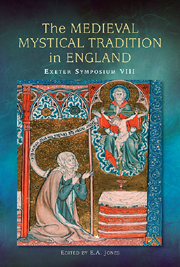 The Medieval Mystical Tradition in England
The Medieval Mystical Tradition in England Published online by Cambridge University Press: 05 July 2013
The works of two exemplary figures of fourteenth-century spirituality, Henry Suso and Richard Rolle, grant us insight into some of the most significant commonalities between the devotional cultures of fourteenth-century England and Germany. The reception history of the two authors demonstrates their skill in composing narratives and creating characters which subsequent generations of readers found compelling aides to their spiritual development and contemplative practices. The similarities between the two authors, while to a certain extent rooted in some of their common sources, nevertheless testify to the popularity of a particular type of self-fashioning as both author and eponymous character. Both this strategy of authorial self-presentation and the array of thematic commonalities they share can shape our understanding of the role their texts played in the process of transmission and translation of spiritual concepts between England and Germany in the later Middle Ages. Suso and Rolle, besides their many thematic and structural similarities, also had particular success in capturing the attention of readers and translators both religious and lay from the second half of the fourteenth century until the beginning of the seventeenth.
In particular, one of the central points of commonality between Suso and Rolle lies in what I term ‘devotional mobility’. By this I mean not only the instances of physical and spiritual mobility inherent in both (for instance, Rolle's account of wandering between insufficiently solitary hermitages and Suso's persecution while on trips to provincial chapters demonstrate the role of physical mobility in their self-descriptions; both explore the directional framework of spiritual ascent within the space of the visionary event as a type of spiritual mobility).
To save this book to your Kindle, first ensure [email protected] is added to your Approved Personal Document E-mail List under your Personal Document Settings on the Manage Your Content and Devices page of your Amazon account. Then enter the ‘name’ part of your Kindle email address below. Find out more about saving to your Kindle.
Note you can select to save to either the @free.kindle.com or @kindle.com variations. ‘@free.kindle.com’ emails are free but can only be saved to your device when it is connected to wi-fi. ‘@kindle.com’ emails can be delivered even when you are not connected to wi-fi, but note that service fees apply.
Find out more about the Kindle Personal Document Service.
To save content items to your account, please confirm that you agree to abide by our usage policies. If this is the first time you use this feature, you will be asked to authorise Cambridge Core to connect with your account. Find out more about saving content to Dropbox.
To save content items to your account, please confirm that you agree to abide by our usage policies. If this is the first time you use this feature, you will be asked to authorise Cambridge Core to connect with your account. Find out more about saving content to Google Drive.